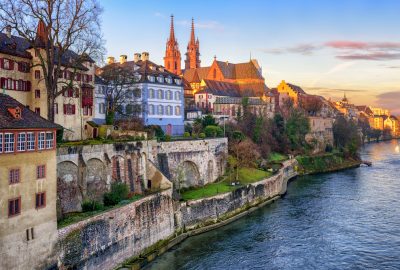Basel is what a 21st century European should be like to my opinion. Not too modern, but not too stuck in the past either. It’s very multicultural and open-minded, probably because Basel is where Switzerland, Germany and France meet. That three-way border is an important part of local identity. The inherent multinationalism opened a way for ex-pats and international corporations. Pharmaceutical giants such as Novartis and Roche are a good example. Roche’s very own skyscraper is in fact the tallest building in Switzerland. There’s been a hilarious rivalry between Basel and Zürich for decades. Who builds the tallest skyscraper, or lures more tourists in; stuff like that. Basel takes the lead…for now. It used to be the largest and most prosperous city in Switzerland. You can see all that former (and current) glory in its architecture. I’d go as far as saying that parts of the Rhine riverbanks remind me of Florence. Both cities share their love for art stored in galleries and museums.

Basel Minster, the oldest temple in Basel with reddish sandstone walls, patterned tiled roofs and slender twin towers, is the main decoration of the cityscape
There are 40 museums in Basel, which is an amazing number for such a relatively small city. Start your journey at the Old Town; it’s the best part of every medieval city. The Marktplatz is the main square in Old Basel; it functions as a farmer’s market to this day. The one thing that stands out here is the most beautiful Town Hall. It was built between the 16th and 18th century, when people decided the old Town Hall was outdated. This stunning red building has functioned as the seat of the government ever since. There’s a charming inner courtyard, but the main feature is on the outside. The arcades and the characteristic red wall were decorated by paintings of Basel’s very own Hans Bock. He was a big shot when it came to German art of that period. You probably noticed the basilisk. It often appears on fountains and various monuments across Basel. Basilea is another name for Basel, closely connected to the mythical creature. According to legend, a basilisk used to live in a cavern below the modern-day Gerberbrunnen (Tanner Fountain). Another story dates back to 1474 when a cockerel was sentenced to death for (allegedly) laying an egg. A proper trial took place, as people were scared shitless that it will spawn a basilisk. Everyone knows you can’t just kill a basilisk, you need a weasel, a crow, or a mirror, not easy things to obtain in the middle ages.

Built in the Gothic style, the Town Hall in Basel evokes admiration both for the architecture in general and for the nuances in particular such as the clock of the beginning of the 16th century, the coat of arms above the entrance, and the statue of Munatis Plancus in the courtyard
Pick up a bag of Basler Läckerli biscuits at the closest Läckerli Huus and walk towards the Rhine. You can stop by the Museum of Natural History on the way. If you had to pick a few out of 40 museums in Basel then this one should be on that list. I’d close it with the Pharmacy Museum, showcasing stuff that made Paracelsus settle in Basel for a while. The Tinguely Museum is also exceptional. It’s named after the famous artist/inventor who built one of Basel’s iconic fountains. Make sure you visit the Münster Square (Münsterplatz) if you’re in Basel in December. This is where Switzerland’s top (according to the locals) Christmas market takes place. This square is also where you’ll find Basel’s most important landmark. The cathedral is not too big, not too spectacular, it’s just right. The original building was destroyed in the Basel earthquake in 1356. It was rebuilt in 1500, which means it’s almost 600 years old.
Basel is a bit of a natural anomaly in Central Europe. They have earthquakes and even the climate is peculiar. Trees and plants that, technically shouldn’t grow in this region, are flourishing. It might not be 30+ degrees all the time, but Basel claims they do have 300 days of sunshine every year. That brings us to my favorite part: the Rhine. It blows my mind how you can swim in a river that flows right through a city. They build an entire infrastructure around it, making the Rhine a centerpiece of the Basel experience. Urban beaches, water trams, not to mention the cookie-cutter riverbank bars, cafes, and restaurants. You can grab one of those floaty bags, pack your stuff and let the current take you. It’s free public transport. Late for a meeting? Strip down and jump into the Rhine, it’s better than waiting for an Uber.




No one commented yet. Be the first.